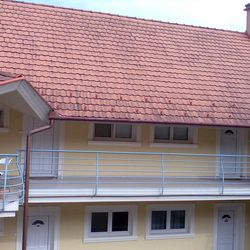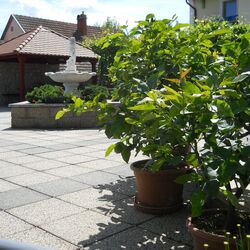

Ham, sausage, pork cracklings, and authentic countryside hospitality
Zsankó Family Farm is not just about products — it’s about preserving a heritage of respect for traditional flavors and homemade recipes. Officially founded in 2018, its roots stretch back much further. Memories of pig slaughters and the comforting aroma of home still guide Norbert, the heart and soul of the farm, in his everyday work.
Here, you’ll taste products that revive childhood memories: smoked Mangalica and Duroc ham, sausages, pork cracklings — just to name the bestsellers.
A visit to the Zsankó farm gives you the chance to see how these rural delicacies are made.
From family heritage to personal mission
Located in Zalaszentlászló, the farm is built on the former home of Norbert’s in-laws — now the heart of this artisan venture. For Norbert, there was no question he wanted to continue what his grandparents started: making high-quality, additive-free, real food.
The house, built by his father-in-law’s own hands, now houses a modern small-scale processing facility. As a child, Norbert often took part in traditional pig slaughters. Little did he know these memories would one day shape the foundation of “Grandma’s Flavors” Family Farm.
Simple ingredients, timeless flavors
The farm currently raises 60–70 pigs of three breeds: native Mangalica, American Duroc, and crossbreeds — ensuring a perfect balance of fatty and lean products to suit every taste. The pigs roam freely, and most of their feed is grown on the family’s own land, so they know exactly what goes into their animals — and ultimately, onto their customers’ plates.
Their range includes smoked ham, sausage, pork cracklings, and lard. Seasonally, Norbert also produces blood sausage, grill sausages, pork neck, liver pâté, and pork jelly — all made the traditional Zala way, without artificial additives or colorants.
Norbert takes pride in sticking to recipes passed down through generations: only salt, pepper, garlic, and paprika. Nothing more. Smoking is done using beech wood and, occasionally, fruitwood, following the old cold-smoking methods.
A brand that’s a way of life
“Grandma’s Flavors” is more than just a name — it’s a way of life, promoting a return to authentic tastes. Norbert’s philosophy is simple: he only sells what he would gladly serve his own family. Purchases are made directly at the farm, next to the processing facility, giving customers the chance to experience the products and hear the stories firsthand.
For Norbert, the greatest reward is when an elderly grandmother says with tears in her eyes, “This tastes just like it used to.” He couldn’t ask for more.
Farm tours & traditional tasting experience
Curious to see how a small rural operation works? Want to learn how Zsankó products are made? Norbert will gladly show you around, introduce you to the pigs, and even give you a peek inside the smokehouse.
As an extra treat, you can also book a countryside table experience, where you’ll enjoy “Grandma’s flavors” right in their Zalaszentlászló courtyard. Just call ahead to arrange a visit.
Product highlights
Smoked ham
Zsankó Norbert’s smoked ham is in no rush — and that’s exactly what makes it so special. Premium pork rests in a brine of salt, garlic, and pepper for 4–6 weeks. This is followed by slow cold-smoking using beech wood only.
The result: a deep, yet elegant smoky flavor in every bite. The meat is firm, not spongy or watery, perfectly sliceable, and naturally salted. Completely free of additives or flavor enhancers — just as tradition demands.
Homemade Zala-style sausage
This sausage is not just “homemade” — it’s made the same way grandmothers used to prepare it. The recipe hasn’t changed for generations: fresh, high-quality meat, just the right amount of fat, seasoned with salt, pepper, garlic, and premium paprika. Nothing else.
The seasoned meat is stuffed into natural casings and slowly smoked over beech wood for several days. This method gives the sausage its rich red color, full but balanced flavor, and slightly firm texture.
Whether it’s breakfast, dinner, a charcuterie board, or a wine pairing — this sausage never goes unnoticed.
Where to find Zsankó “Grandma’s Flavors” Family Farm:
- 8788 Zalaszentlászló, Rákóczi Ferenc Street 13
- Google Maps
More information & Contact:
- Phone: +36 20 234 2013
About 10,000 years ago, rapid climate warming triggered a cascade of natural responses: torrential floods, landslides, and intense rock weathering. The landscape we walk on today was not shaped over mere centuries, but by the dramatic forces of climate and water, working together. Did you know that the Zala Valley floor is made up of sediments deposited by a kind of "river of time"? Discover how the Earth’s surface became one of the most sensitive indicators of climate change. We often associate climate change with contemporary issues, but Earth’s climate has shifted many times throughout its history — sometimes quite rapidly. Within large-scale climatic cycles, alternating periods of warming and cooling have long been part of the planet’s natural rhythm. A change in climate sets off a chain reaction of environmental processes. It’s not just animals and plants that respond — so does the landscape itself. Around 10,000 years ago, as the climate warmed significantly, rainfall became more intense. More rain meant more erosion: stormwater began washing away sediment from hills and valleys into riverbeds. The rivers, now carrying more water and more sediment, flooded more often and spread these materials across the landscape. This had a major impact on topography: the land surface became more fragmented and dynamic. Warming temperatures also sped up chemical and physical weathering, breaking down bedrock and helping fertile soil layers to develop. Today, in many areas of the region, the lower slopes and valley edges are coated with sediment — debris washed down from higher ground, largely within the last 10,000–20,000 years. In the Zala Valley, for instance, these deposits have spread so far that they now reach the center of the valley floor. The original bedrock source of these sediments varies: in Zala, it’s typically Pannonian sand (Somló Formation), while in the Keszthely Hills, marine-origin carbonates dominate — mostly dolomite, with some limestone. These sediments now appear as fine gravel, pebbles, or coarse sand, quietly recording the environmental changes of the recent past.
Climate Change: Not Just a Modern Phenomenon
When Climate Changes, Everything Reacts
Shaping the Terrain
In short, natural geological processes that had long been underway suddenly accelerated — and reshaped the surface of the land.Young Sediments at the Base of the Slopes













